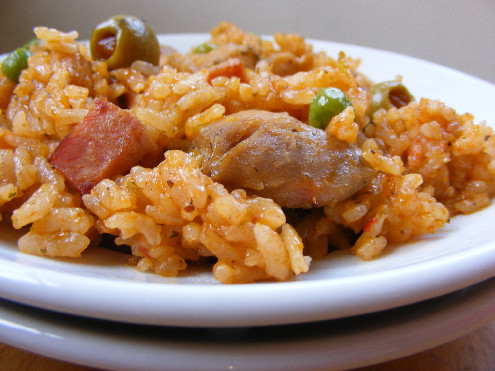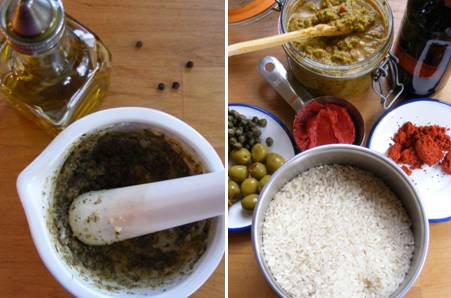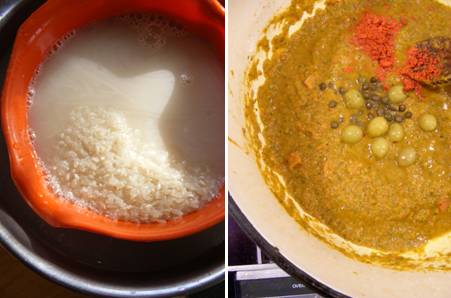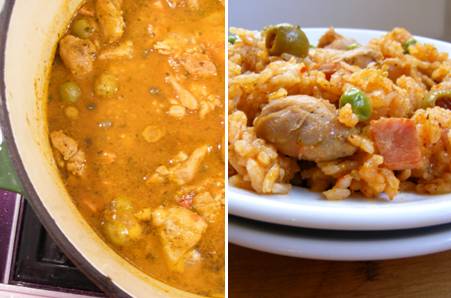A couple of months ago my amiga Kitty and I spent an afternoon cooking. She offered to show me how to make Puerto Rican arroz con pollo, rice with chicken.
I happily assumed the role of sous chef – peeling heads of garlic, chopping veggies, and stirring this and that. Meanwhile, Nivia was my window into the cultural and personal nuances of Puerto Rican cookery . . .
For starters, Puerto Rican cuisine employs a spectrum of cooking techniques and ingredients that reflect the island’s diverse inhabitants: the Caribbean native Tainos, Africans, Spanish, and other Europeans.
Three items are signature to the cuisine: adobo, sofrito and achiote. Arroz con pollo employs all three. No wonder it’s touted as the most popular chicken dish on the island.
Adobo: In Puerto Rican parlance, adobo is a seasoned salt. A wet adobo made of garlic, olive oil, salt, black pepper, oregano and citrus juice is rubbed on the chicken in this dish and marinated overnight. It’s the secret to moist and flavorful chicken, and it also infuses a layer of flavor to the rice. Sofrito: The rice is bursting with flavor because of the sofrito, a fresh bouillon of peppers, onions, garlic and herbs. (Read about sofrito and view recipe.) Achiote: Achiote is derived from annato seeds and is used for its subtle flavor and to give the dish a reddish hue. No saffron here, the less expensive achiote is a long-time tradition in Puerto Rican cooking. Achiote can be purchased as a paste, ground or in seed form. It is readily available in Latino markets and spice stores.
After cooking with Kitty, I did some research. The majority of recipes out there are more intuitive rather than specific. For a Puerto Rican arroz con pollo novice, that’s not helpful. I know, I made this dish three times in the last several weeks.
Here’s my final recipe, with a bit more detail – I’ve borrowed techniques I learned from Kitty, other Puerto Rican friends and research. Remember it’s the process that matters, so make certain to read the instructions thoroughly before you begin.
It serves six. You’ll be glad to have leftovers!
One more thing, don’t forget the little bits of crispy, cooked rice at the bottom of the pan are called “pegao.” It’s considered the best part of arroz con pollo by some aficionados.
Tidbits on Rice
- Rice was introduced to Puerto Rico by Columbus in his second trip to America in 1493 and has since become a primary food source.
- Long grain rice is said to be favored in Puerto Rico, according to some sources. However, medium and short grain rice are heavily favored in dishes like arroz con pollo and arroz con gandules.
- Arroz con pollo dates back to the eighth century to Andalusia, when the Moors occupied Spain. It has become a popular rice dish in nearly all of Latin America and the Caribbean, with regional variations, of course.
Sources: The Oxford Encyclopedia of Food and Drink in America; Puerto Rican Dishes by Berta Cabanillas and Carmen Ginorio.
Puerto Rican Rice and Chicken – Arroz con Pollo
Serves 6
Plan Ahead: Be sure to read through the complete instructions in advance of cooking. For optimum flavor, marinate the chicken the day before cooking.
Chicken: Dark meat such as thighs are preferable, although I have used chicken breasts in a pinch.
Pot/Utensils: Use a heavy pot such as a Dutch oven or caldero with a tight fitting lid. Use a fork to turn the rice and NOT a spoon or spatula, which can make the final rice dish mushy.
Temperature: Pay attention to the instruction on the level of heat to be used.
Ingredients
Adobo Marinade for Chicken
2 teaspoons salt
12 whole black peppercorns or 1/4 teaspoon course black pepper
2 cloves garlic
1 1/2 teaspoon dried oregano
2 teaspoons olive oil
1 teaspoon lemon/lime juice or vinegar
2 pounds chicken (about 8 thighs with bone)
Rice and Chicken
1 tablespoon olive oil or vegetable oil
2 ounces lean cured ham, diced (about 1/4 cup)
1/2 cup beer or white wine
3/4 cup sofrito
1/4 cup tomato sauce or paste
Whole green olives (small handful 8 to 12)
1 tablespoon capers
1 tablespoon achiote paste
2 1/2 cups medium white rice
3 1/4 cups chicken stock, heated
1 cup peas (fresh or frozen), defrost
Pimientos, optional for garnish
Method
- Chicken Adobo Marinade: Prepare the day before cooking or at least 4 hours in advance. Use a mortar and pestle to grind all ingredients (except for chicken) to make a paste. Prepare chicken for marinade – remove skin, debone thighs and cut into 3 to 4 inch pieces. Don’t fuss if there’s a little meat on the bone because the bones will be used to make stock. Set bones aside in a small pot. Add the marinade to the chicken and store in a covered glass container or large re-sealable plastic freezer bag. Refrigerate and marinate overnight or at minimum 4 hours.
- Stock: To make a quick chicken stock for arroz con pollo, add 5 cups of water to the chicken bones. Bring to a boil, skim off skum and reduce heat to medium low and simmer for about 30 minutes. Remove bones and remove excess chicken. Refrigerate. When ready to use, skim off the layer of fat that separated.
- Arroz con Pollo: Rinse rice in a colander with a bowl underneath until water is clear. Then, let rice sit in hot water; set aside.
- In a large, heavy pot (with a tight fitting lid) such as a Dutch oven or caldero, heat oil and brown diced ham on high heat. Reduce to medium heat and add chicken pieces; cook for about 3 to 4 minutes on each side, until slightly browned. Remove chicken and set aside. Deglaze pot with beer or white wine, scraping bottom of pot with a wooden spoon. Once the caramelized bits stuck to the bottom of the pot are loosened, reduce to low heat and add sofrito. Saute for about 8 to 10 minutes. Then add tomato sauce. Saute for 1 to 2 minutes more. Add olives, capers, and achiote paste. Mix well.
- Return chicken to pot. Add hot chicken stock. Drain rice in colander and add to pot; give a few stirs. Over medium heat, bring mixture to a slight boil, and cook for about 7 minutes uncovered, (at this stage some of the liquid will have been absorbed but rice should not visible). Use a fork to turn rice from the bottom to the top.
- Cover pot and reduce to low heat; simmer for 20 minutes. Add defrosted peas and turn rice from the bottom again with fork. Recover with lid and continue to simmer for about 20 more minutes, until rice is cooked. Avoid removing lid excessively. Turn off heat and let sit for 10 minutes. Fluff with a fork.
- Serve with habichuelas or black beans and tostones.
Variation
Stock: Add onions, bay leaf, garlic carrots for additional flavor
Tags: achiote, adobo, Andalusia, arroz rojo, comfort food, history, pegao, recipe, sofrito










Save me some….
Wow, great post! So comprehensive. It’s interesting you can use wine OR beer. Seems like those would have two very different results. Also, I was surprised to see you added the olives and capers so early. I would have thought to add them when you put the peas in so they wouldn’t overcook. Do olives and capers shrink up? I know I have used them many times in Snapper Veracruz and didn’t have a problem, but that doesn’t cook as long as your rice.
Andrea (FFC): I’ve used both and they do change the taste slightly. Lately, I’ve had a preference for the boldness of beer. Re the timing of adding the olives and capers. The olives do not shrink up and the capers do a little. One of the added pluses of adding early is that the saltiness and olive taste stews and infuses the flavor of the rice more. For prettier capers, though, add them later. FYI, you can add the peas at the very end, along with diced pimentos.
My cousin recommended this blog and she was totally right keep up the fantastic work!
What a great resource!
Andrea (FFC): Thanks for visiting the site.
What type of rice do you recommend? Just plain old medium white? I’m thinking the steps you take in washing and letting the rice sit must be important to the end result or have you tried making it without those steps? Recently, I bought some fancy Bomba Rice from Spain to make a similar paella and had disasterous results so I’m a little wary of my rice now. Thanks!
Andrea (FFC): I used a regular (plain old) medium white grain rice. You are correct, the steps re the rice are important for this recipe. Rinsing the rice removes a lot of the starchy coating, soaking the rice in liquid softens the grains (cutting back on the cooking time and reducing the likelihood of burning the rice at the bottom of the pot).
My recommendation is to try a medium white rice from any mainstream market. It’s a regular rice and not Calrose and not a glutinous (starchy rice). Follow the steps I outlined; if you don’t, you’ll have to make adjustments such as adding more water and increase cooking time. FYI, there’s no consensus even among Puerto Ricans about rinsing and soaking rice. I made this dish on my own several times and know that rice can be tricky. But, when you master this dish, you’ll be so glad you did. Also, be mindful of the levels of heat as well as your pot.
If your rice is still a bit crunchy, spread it out in a baking dish, add a tad bit of water, cover tightly with foil and bake for 10 to 15 minutes at 350. Fluff with a fork.
Be cautious whenever having too much beer because it can easily end up in alcohol addiction. Ofcourse if you are an enjoyer of life just like i am then you might not care!
One of my Puerto Rican friends, a former caterer, makes her version using Goya soffits, recaito and Sazon. Have you tried using there?
That is supposed to be Sofrito. My iPad keeps “correcting” my spelling.
sofrito